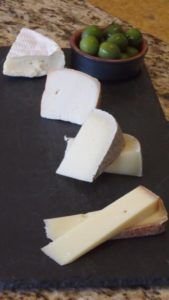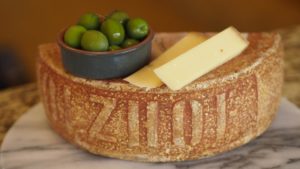
Editor’s Note: This sponsored column is written by Katie Carter, cheesemonger at Arrowine (4508 Lee Highway)
A cheese plate doesn’t need to be complicated. It can be as simple as one boss cheese paired with the perfect wine or a flight of various cheeses. Building a cheese plate should never be a daunting task. It’s fun, easy, and takes no time at all. By all means, choose the cheeses that you (or guests) like but try to keep a few things in mind before plating.
Mix up textures. Unless you are going for a theme that will dictate texture (i.e. aged pecorinos), you should try to vary the textures from soft to firm. There’s a huge range of textures in cheese so this is relatively simple. If you have a super runny or goopy cheese, contain it so it does not get too messy and provide a spoon.
Include different milk types. For a nice range of flavors, choose at least three out of the four options we have here in the States: goat, cow, sheep, or water buffalo. There are many blends out there, too.
Offer cheese of various origins. Again, unless you have a country theme (i.e. all French), try to pick cheeses from many sources. These days it is very easy to find cheese from many countries.
Plate the cheeses in order of strength of flavor. You never want to start with a blue or washed rind style, which will overpower the flavors of anything gentler. Provide a separate serving tool for each cheese to keep the cheeses clean and flavors separated. If you are choosing one wine or beer to pair with the whole plate, pick something that’s relatively friendly to all of them.
Fresh or dried fruit (other than citrus), nuts, olives, and bread are all great accompaniments. You can also serve honey, chutneys, jams, or preserves on the side.
Here’s what I am enjoying this week (all pictured):
This pasteurized Ayrshire cow’s milk cheese comes from one of the most innovative cheesemakers in the States, Jasper HIll Farm. In the soft ripened style, this cheese has a fresh milky flavor complimented by mushrooms.
Cabra Raiano
A soft, pudgy goat’s milk cheese from central Portugal. This is a “torta” style cheese made by coagulating fresh milk with the cardoon thistle, a naturally vegetarian coagulant. The final cheese is rich and vegetal with a thick, creamy mouth feel.
Cinerino
A semi soft, raw sheep’s milk cheese from Castelcivita in southern Italy. This supple cheese offers clean hay and lanolin flavors. An excellent example of a well made Italian pecorino.
This aged, raw cow’s milk cheese is absolutely beautiful. Aged for eight months, this cheese is big and bold! Made by a third generation cheesemaker in north eastern Switzerland, Holzhofer is rich, nutty, and complex. As a bonus, the firm, dense paste has those lovely crunchy protein crystals.
Show me your plate! Construct a cheese plate, take a decent pic, and send it to [email protected]. I’ll try to include it in the next column. Have a great weekend!
Katie Carter is Arlington’s first and only ACS Certified Cheese Professional. She has worked in the cheese industry for ten years as a cheesemaker, cheesemonger, and educator. She can be found on Twitter @AfinaCheese. The views and opinions expressed in the column are those of the author and do not necessarily reflect the views of ARLnow.com.
Photo credit: Steve Lee



